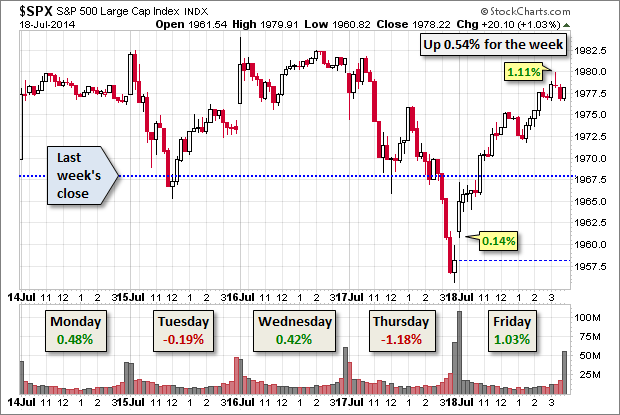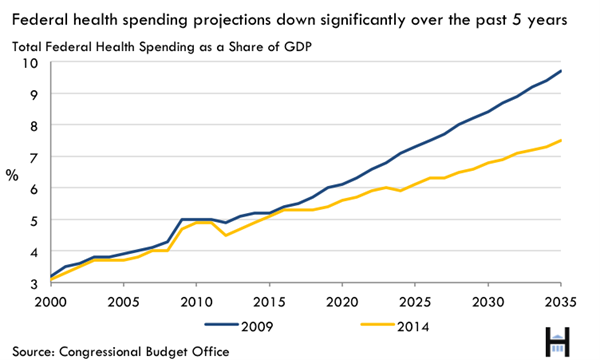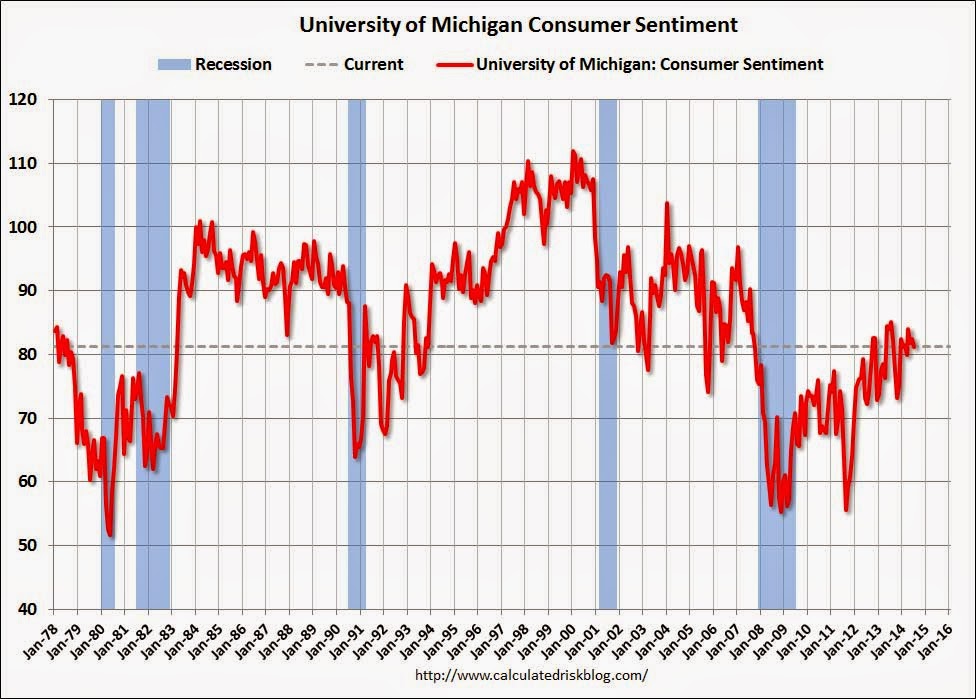To the surprise of many observers, stocks have survived a series of recent challenges. As Q2 '14 earnings reports starts begin, the questions has changed:
Can strong corporate earnings spark a renewed rally in stocks?
Prior Theme Recap
Two weeks ago I expected that speculation about a market correction would dominate the time before earnings season began. This proved to be accurate, especially when assorted news items were linked to a market decline of more than 50 bps. It does not take much these days to get the financial media excited, e.g. The Dow is down triple digits!! Whoever happens to be on TV at the moment is asked to “explain” the decline.
Naturally we would all like to know the direction of the market in advance. Good luck with that! Second best is planning what to look for and how to react. That is the purpose of considering possible themes for the week ahead.
This Week’s Theme
The stock market has successfully shrugged off a series of recent challenges, including the following:
- A Portuguese banking “crisis”;
- A front-page New York Times story explaining that all investments are “expensive”;
- A streak of weak economic data;
- A series of geo-political concerns – Ukraine, Iraq, and Gaza.
- Some advice on stocks from Fed Chair Janet Yellen. (See Steven Russolillo’s WSJ piece and Neil Irwin at The Upshot to get some grounding on this issue!)
Doug Short always captures the week in a single great chart. This one shows the resilience last week.
The chart would be even more dramatic if it included overnight futures trading on Thursday. Those of us sneaking a peek or two in the wee hours noted that futures were down “triple digits” on the Dow. More on that subject in this week’s Final Thought.
After surviving these various tests, it may be time to consider the upside. Will earnings growth be enough to propel stocks higher?
Barron’s cites “earnings based optimism” as the source of strength. Eddy Elfenbein notes that estimates have come down less than we usually see, and also warns about the deviations in various earnings sources. Brian Gilmartin confirms Eddy’s observation and also notes that we are seeing some revenue beats as well this quarter.
I am not seeing major sources projecting that earnings will be poor, but feel free to highlight such forecasts in the comments. I have some final thoughts, as usual, but focused more on world events than earnings.
First, let us do our regular update of the last week’s news and data. Readers, especially those new to this series, will benefit from reading the background information.
Last Week’s Data
Each week I break down events into good and bad. Often there is “ugly” and on rare occasions something really good. My working definition of “good” has two components:
- The news is market-friendly. Our personal policy preferences are not relevant for this test. And especially – no politics.
- It is better than expectations.
The Good
There was some important good news last week.
- Sea container counts improve again.Steven Hansen notes the recent improvement and provides a package of charts illustrating the longer trends.
- Earnings reports have been positive, but only 10% of companies have reported. Bespoke’s beat rate chart tells the story:
- Yellen’s Congressional testimony was market-friendly. Reassuring and no missteps. Whether or not you agree with the plan, investors should take it for what it is. Here are four good takes on the story.
- Health care spending cost forecasts are improving. The non-partisan CBO shows health care taking a lower share of GDP than projected a few years ago. Health policy remains a hot-button political issue. Everyone on all sides is either assigning blame or taking credit. As investors, we should be interested in facts – especially if worried about the budget deficit. Matthew Yglesias at Vox reviews data from a Brookings study. Here is a key chart:
The CBO still sees the “risk of a fiscal crisis” without policy changes.
The Bad
The important economic news last week was mostly negative.
- Industrial production missed expectations. Growth of 0.2% is disappointing.
- Tax inversions will cost the US $20 billion in the next decade unless there is action. (Via WSJ).
- Housing data missed badly. This included both housing starts and building permits. Calculated Risk is our favorite source on housing. Bill acknowledges the miss, but still sees the single-family data as consistent with his “broad bottom” thesis. To be fair, this has been his viewpoint for many months. He has plenty of good charts, but let’s focus on the bad news from this month:
Michigan sentiment fell to 81.3, a four month low. Calculated Risk has the story and this chart:
The Ugly
The ongoing conflicts and resulting death and injuries. Whether terrorism or war, the issues seem intractable.
The Silver Bullet
I occasionally give the Silver Bullet award to someone who takes up an unpopular or thankless cause, doing the real work to demonstrate the facts. Think of The Lone Ranger.
This week’s award goes to John Lounsbury at Econintersect for his careful and educational analysis of Japanese machinery orders. Your favorite doomer site (a happy hunting ground for those seeking to win the Silver Bullet) garnered plenty of attention and page views with the “Japocalypse” headline. It is so easy to take a volatile data series and pick a single point out of context. It is especially effective when many see Japan as a good analogy for issues in the US.
John Lounsbury looks at the complete data history, showing both the raw data reports as well as long and short-term trends. His charts tell the whole story, but here is the key summary:
Whether the May readings have any special significance or not will not be known at least until the June data is reported, and probably not known with any certainty until at least three more months are on the books.
In the meantime, terms like “Japocalypse” can be put back on the shelf (under a dust cover) in case they are actually needed later when the long-term wild up and down swings in new machinery orders are ended with an extended move to the downside.
For another side of John, read his post on employer discrimination against Republicans. (If you have any questions about this one, please check the end of this article).
Quant Corner
Whether a trader or an investor, you need to understand risk. I monitor many quantitative reports and highlight the best methods in this weekly update. For more information on each source, check here.
Recent Expert Commentary on Recession Odds and Market Trends
RecessionAlert: A variety of strong quantitative indicators for both economic and market analysis.
Doug Short: An update of the regular ECRI analysis with a good history, commentary, detailed analysis and charts. If you are still listening to the ECRI (2 ½ years after their recession call), you should be reading this carefully. Doug includes the most recent ECRI discussion, which has been consistently bearish, including the blown call on the recession. We included Doug’s chart of the Big Four last week, but data devotees should check it whenever there is a big release. It has now been updated for the employment data.
Georg Vrba: Updates his unemployment rate recession indicator, confirming that there is no recession signal. Georg’s BCI index also shows no recession in sight. For those interested in hedging their large-cap exposure, Georg has unveiled a new system. Georg now has another new program, with ideas for minimum volatility stocks for tax-efficient returns. He also has new advice for those seeking a safe withdrawal rate.
Bob Dieli does a monthly update (subscription required) after the employment report and also a monthly overview analysis. He follows many concurrent indicators to supplement our featured “C Score.” One of his conclusions is whether a month is “recession eligible.” His analysis shows that none of the next nine months could qualify. I respect this because Bob (whose career has been with banks and private clients) has been far more accurate than the high-profile TV pundits.
The National Association of Business Economists survey puts the odds of a recession in 2014 or 2015 at less than 10% (looking farther into the future than we find comfortable). They also see the date of the first Fed rate hike coming sooner.
The Week Ahead
We have a moderate week for economic data.
The “A List” includes the following:
- Initial jobless claims (Th). The best concurrent news on employment trends.
- CPI (T). Real concern about inflation is still not imminent, but the recent increase has attracted more attention and comment. Remember that the Fed is seeking an increase and also uses the PCE, which is still benign. If the measures diverge, it will become controversial, so I am promoting this to the “A list.”
- New home sales (Th). Important driver of economic growth.
The “B List” includes the following:
- Existing home sales (T). Less economic significance than new home sales, but still a good concurrent read on housing.
- Durable goods (F). Bounce back in June data expected.
Earnings stories will dominate.
Events in any of the world hot spots could also command attention.
How to Use the Weekly Data Updates
In the WTWA series I try to share what I am thinking as I prepare for the coming week. I write each post as if I were speaking directly to one of my clients. Each client is different, so I have five different programs ranging from very conservative bond ladders to very aggressive trading programs. It is not a “one size fits all” approach.
To get the maximum benefit from my updates you need to have a self-assessment of your objectives. Are you most interested in preserving wealth? Or like most of us, do you still need to create wealth? How much risk is right for your temperament and circumstances?
My weekly insights often suggest a different course of action depending upon your objectives and time frames. They also accurately describe what I am doing in the programs I manage.
Insight for Traders
Felix has turned neutral with confidence reduced. Uncertainty remains high – typical for a trading range market. This week we were only partially invested in one or two of the top sectors for our trading accounts. That remains our position going into the week ahead, although some of the strength is outside of the US.
You can sign up for Felix’s weekly ratings updates via email to etf at newarc dot com.
Insight for Investors
I review the themes here each week and refresh when needed. For investors, as we would expect, the key ideas may stay on the list longer than the updates for traders. The current “actionable investment advice” is summarized here. In addition, be sure to read this week’s final thought.
The market still did not provide the “dip to buy” sought by so many. The gentle upward action is fine for long-term investors and excellent for those trying out our Enhanced Yield approach. We added positions in stocks that represented good value with solid income from call premiums.
Here are some key themes and the best investment posts we saw last week.
Worried about a market top? Josh Brown provides a short lesson about market tops, comparing key points from the current situation with 2000 and 2007. As he often does, he hits the most important element of the difference, low interest rates and resulting private growth. Barry Ritholtz also has a column showing the huge extremes of investor behavior at market tops and bottoms. (Summary: We are not close yet).
Stock ideas? Some of our holdings have hit their price targets. Unlike some Wall Street analysts we adjust these regularly, not just when they are hit! This means we are always on the lookout for ideas. It is fine to do screening, but sometimes the quantitative rules do not tell the whole story. Here are two sources with some stocks worth considering. Do your own research, as we do.
Morgan Stanley – via Elena Holodny at Business Insider – ideas for the next 12 months.
Larry Robbins of Glenview Capital discussed holdings at ideas at the Delivering Alpha conference.
Portfolio management? Brian Gilmartin explains the role of bonds in adjusting your overall volatility. He illustrates with helpful data from Morningstar. I strongly agree with the idea of understanding and limiting risk. We use both our Bond Ladder and our Enhanced Yield programs to generate some return from the safer parts of the portfolio.
Avoid scams. Read about an FBI Pump-and-Dump scam to learn the signs.
Upside? Richard Bernstein Advisors (HT reader CS) has an interesting explanation for the high equity risk premium: uncertainty on the part of investors and corporations. He has data and charts to prove his point, concluding as follows:
RBA’s corporate motto is Uncertainty = OpportunitySM. Certainty implies risks not anticipated, and potential disappointment. Uncertainty, however, often suggests higher- than-normal risk premiums and investment opportunity.
A broad swath of data, whether focused on investors or corporations, continues to suggest meaningful uncertainty. Accordingly, we continue to believe this may be an elongated cycle that still offers unrecognized investment opportunities.
If you are worried about possible market declines, you have plenty of company. This is one of the problems where we can help. It is possible to get reasonable returns while controlling risk.
Final Thought
I expect next week’s theme to be earnings, but given current events it is also important to consider world events and risk. Josh Brown, after expressing concern for those suffering casualties, takes the role of the professional investment manager, writing as follows:
Suffice it to say that there is never any more or any less risk of geopolitical threat in the world – there are only changes in perception and the attention paid to the various threats, new and old, that have been with us since the dawn of time.
The notion that there is more uncertainty now than there was last month because of a plane being shot down in the Ukraine or an Israeli incursion into Gaza is both childish and ahistorical. Just because we choose not to be concerned with uncertainty at a given moment – like on September 10th, 2001 for example – that doesn’t mean an outbreak of violence or hostility is any less likely to occur.
So what we’re discussing here now is not a rise in uncertainty itself – but a rise in the awareness of that uncertainty and its subsequent effect on stock prices.
This is very good advice for the average investor, but let me add a few thoughts.
- Many big world changes – end of the cold war, trade expansion, etc. – take longer and provide a longer recognition period. Cam Hui, who has recently been cautious, asks if this is a modern Archduke Ferdinand. Good question! Read his post.
- Some events do provide new information. You need to know what to watch. In the current crises that meant chances for a direct military conflict between Russia and Europe or the US, sanctions on Russia that would affect the world economy, something in any conflict that would further increase oil prices.
- If you know what to watch for, you wake up during the night and check news. For most investors, the specific news would not help.
- Knee-jerk reactions are usually wrong. Investors who sold on Thursday probably did not get back in on Friday.
And most importantly —
If you were frightened about your investments last week, your stock positions are too big. You cannot react logically and effectively if you are paralyzed with fear.






